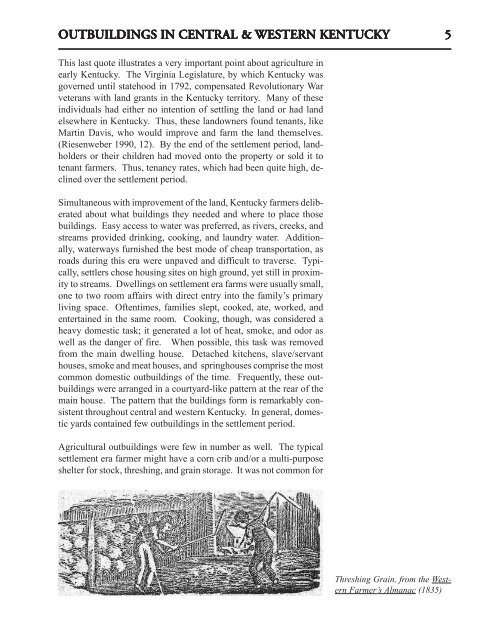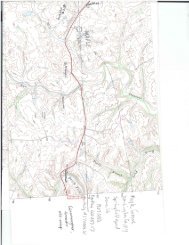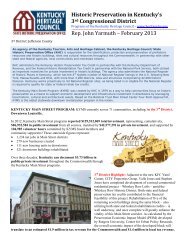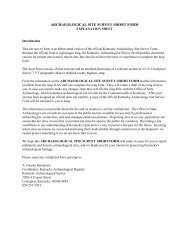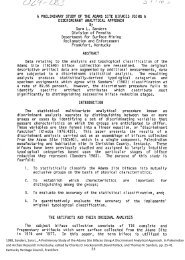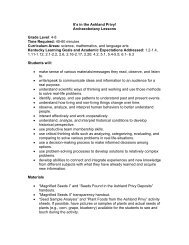Agricultural and Domestic Outbuildings in Central and Western
Agricultural and Domestic Outbuildings in Central and Western
Agricultural and Domestic Outbuildings in Central and Western
Create successful ePaper yourself
Turn your PDF publications into a flip-book with our unique Google optimized e-Paper software.
OUTB OUTB OUTBUILDINGS OUTB OUTB UILDINGS IN IN CENTRAL CENTRAL & & WESTERN WESTERN KENTUCKY KENTUCKY 5<br />
This last quote illustrates a very important po<strong>in</strong>t about agriculture <strong>in</strong><br />
early Kentucky. The Virg<strong>in</strong>ia Legislature, by which Kentucky was<br />
governed until statehood <strong>in</strong> 1792, compensated Revolutionary War<br />
veterans with l<strong>and</strong> grants <strong>in</strong> the Kentucky territory. Many of these<br />
<strong>in</strong>dividuals had either no <strong>in</strong>tention of settl<strong>in</strong>g the l<strong>and</strong> or had l<strong>and</strong><br />
elsewhere <strong>in</strong> Kentucky. Thus, these l<strong>and</strong>owners found tenants, like<br />
Mart<strong>in</strong> Davis, who would improve <strong>and</strong> farm the l<strong>and</strong> themselves.<br />
(Riesenweber 1990, 12). By the end of the settlement period, l<strong>and</strong>holders<br />
or their children had moved onto the property or sold it to<br />
tenant farmers. Thus, tenancy rates, which had been quite high, decl<strong>in</strong>ed<br />
over the settlement period.<br />
Simultaneous with improvement of the l<strong>and</strong>, Kentucky farmers deliberated<br />
about what build<strong>in</strong>gs they needed <strong>and</strong> where to place those<br />
build<strong>in</strong>gs. Easy access to water was preferred, as rivers, creeks, <strong>and</strong><br />
streams provided dr<strong>in</strong>k<strong>in</strong>g, cook<strong>in</strong>g, <strong>and</strong> laundry water. Additionally,<br />
waterways furnished the best mode of cheap transportation, as<br />
roads dur<strong>in</strong>g this era were unpaved <strong>and</strong> difficult to traverse. Typically,<br />
settlers chose hous<strong>in</strong>g sites on high ground, yet still <strong>in</strong> proximity<br />
to streams. Dwell<strong>in</strong>gs on settlement era farms were usually small,<br />
one to two room affairs with direct entry <strong>in</strong>to the family’s primary<br />
liv<strong>in</strong>g space. Oftentimes, families slept, cooked, ate, worked, <strong>and</strong><br />
enterta<strong>in</strong>ed <strong>in</strong> the same room. Cook<strong>in</strong>g, though, was considered a<br />
heavy domestic task; it generated a lot of heat, smoke, <strong>and</strong> odor as<br />
well as the danger of fire. When possible, this task was removed<br />
from the ma<strong>in</strong> dwell<strong>in</strong>g house. Detached kitchens, slave/servant<br />
houses, smoke <strong>and</strong> meat houses, <strong>and</strong> spr<strong>in</strong>ghouses comprise the most<br />
common domestic outbuild<strong>in</strong>gs of the time. Frequently, these outbuild<strong>in</strong>gs<br />
were arranged <strong>in</strong> a courtyard-like pattern at the rear of the<br />
ma<strong>in</strong> house. The pattern that the build<strong>in</strong>gs form is remarkably consistent<br />
throughout central <strong>and</strong> western Kentucky. In general, domestic<br />
yards conta<strong>in</strong>ed few outbuild<strong>in</strong>gs <strong>in</strong> the settlement period.<br />
<strong>Agricultural</strong> outbuild<strong>in</strong>gs were few <strong>in</strong> number as well. The typical<br />
settlement era farmer might have a corn crib <strong>and</strong>/or a multi-purpose<br />
shelter for stock, thresh<strong>in</strong>g, <strong>and</strong> gra<strong>in</strong> storage. It was not common for<br />
Thresh<strong>in</strong>g Gra<strong>in</strong>, from the <strong>Western</strong><br />
Farmer’s Almanac (1835)


